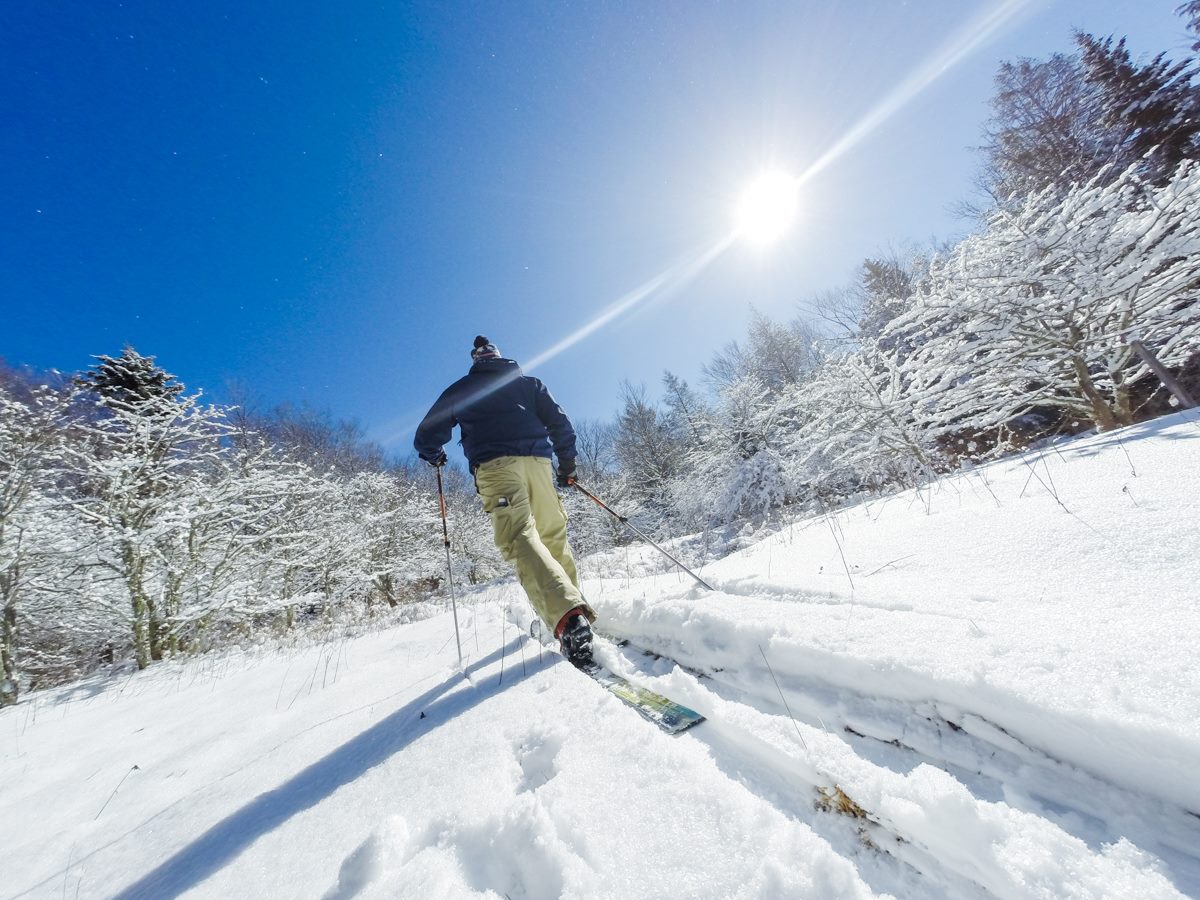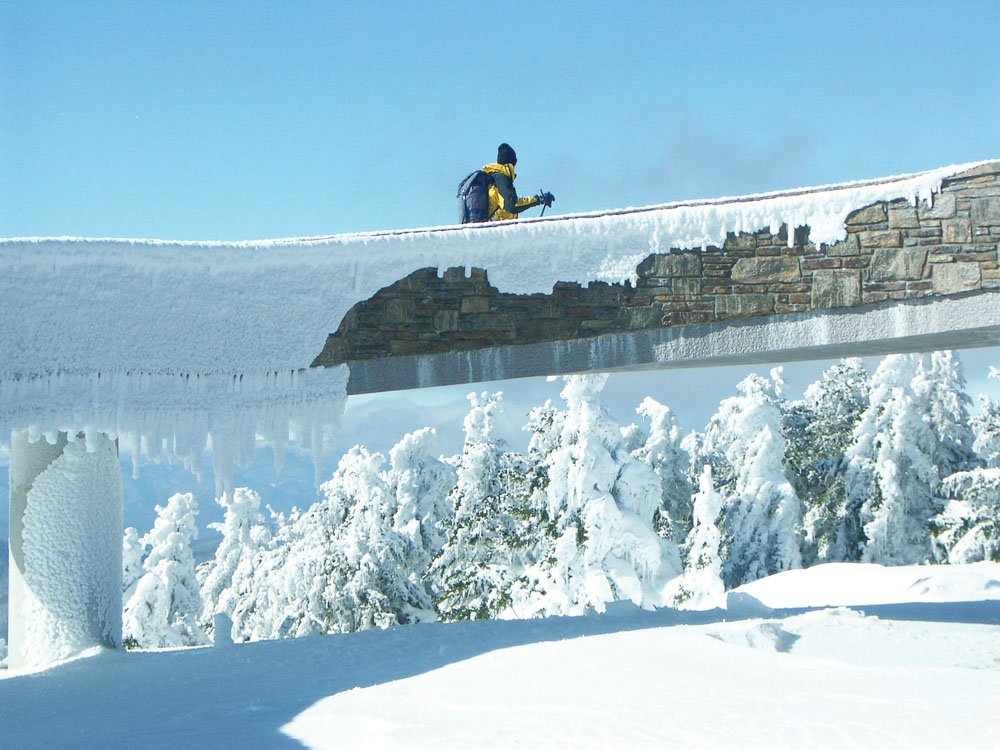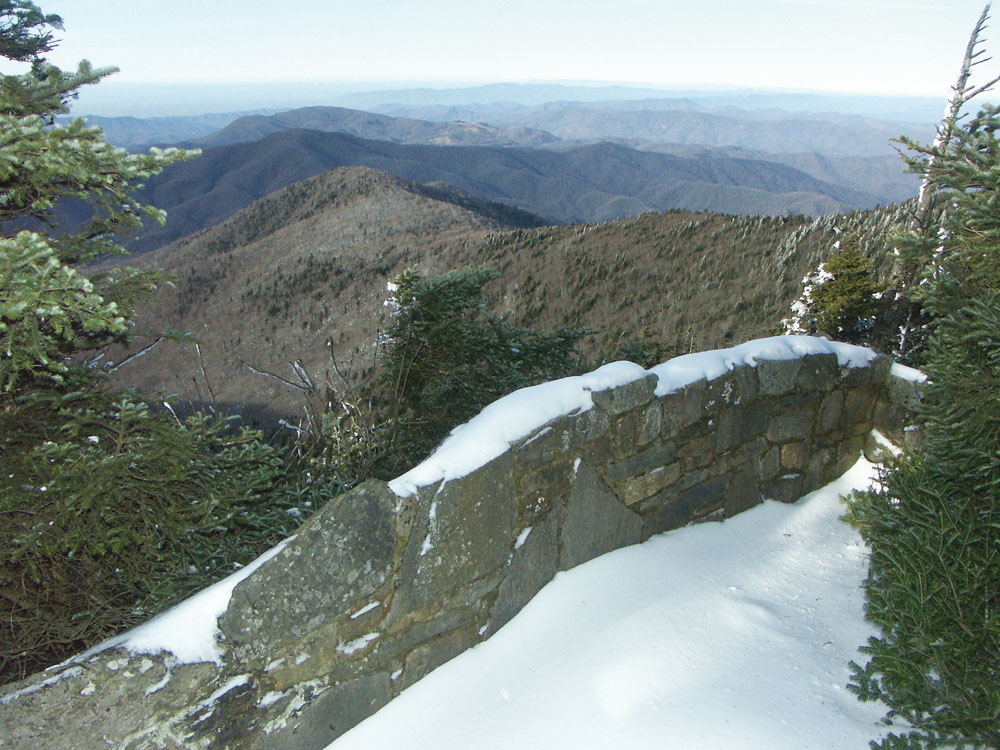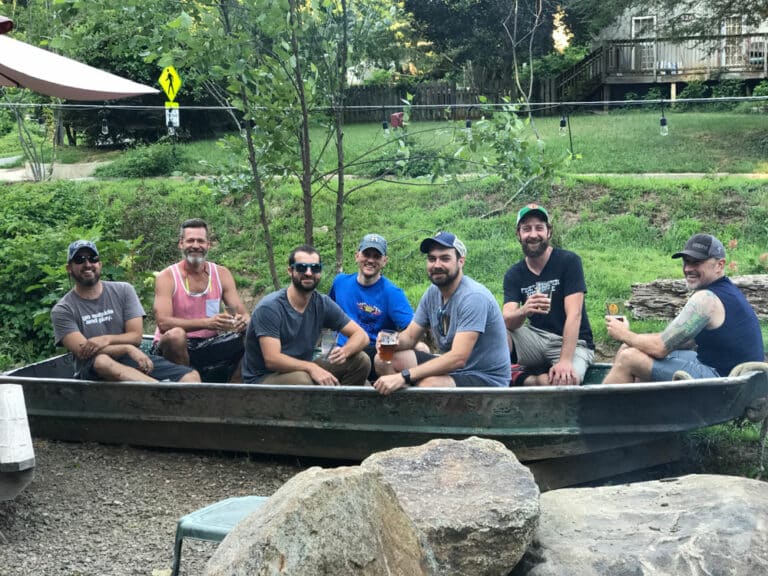The high-elevation Roan Mountain balds are a winter wonderland for cross-country skiing and mountaineering
The first time I drove up to Carver’s Gap in the winter in search of skiable snow, I should’ve known that “Nordic Nirvana,” as I later called it, was hidden just behind the two feet of spring snow being chewed up by rowdy four-wheelers on the road up Roan Mountain. A crowd of crazies from back in the hollers seemed to rule the roost. I slid back into my 1977 Subaru and drove back to Boone.
That was 1978, back when telemarks were finessed in twisty 75 mm “boots” that were more like bedroom slippers. I didn’t see any evidence of backpackers or skiers at the Gap. In the 5,700 foot notch on the Appalachian Trail between the towns of Bakersville and Roan Mountain, winter seemed to be a secret backcountry season. One of the snowiest, most pristine spots in the South, now widely known as a premier portion of the Appalachian Trail, was a recreation area aimed at seeing how deep you could stick your Jeep and whether your winch could get you out.
The winter rewards of skiing and mountaineering on the Roan Massif are better known now, but you still have to look beyond the forest to see the secret runs and routes that hide in the trees. From Roan Mountain at Carver’s Gap to Elk Park, the 13-mile, massive, meadow-covered ridge from Round Bald to Hump Mountain is formidable. But one thing’s for sure: a lot more people are trying.
Bald Beauty
Last winter, I spent weeks on end with snowshoes and skis—and the Roan Mountain balds area was a frequent destination. Almost any time I went, I saw other skiers and snowshoers, with good gear and serious destinations set in their sites. The scene reminded me more of what you see in Colorado than the norm in North Carolina.
One day last February at Carver’s Gap, I tried to do it all—tackle the short list of options that always start for me just beyond the gate on the road up Roan. For twenty-plus years now, the Forest Service has tried to keep the summertime road to the rhododendron gardens gated during the winter, as much to keep four wheelers from freezing to death as to protect the road’s eight feet of skiable snow for people like me (ten inches is all you need). I took a right just above the gate, joined the wide, former horse and buggy road of the A.T., and skied up the switchbacks in a winter wonderland. Maine? New Hampshire? It could have been either.
Luckily last winter’s snow sparked an informal network among serious skiers. I ended up on a Wikispaces telemark skiing site hooking up with other skiers, in part to keep the trail open. While Grandfather Mountain and some other trail systems were closed all winter with heavy ice damage, skiers with folding saws invariably kept Roan’s trails open.
At the height of land just under the Roan High Knob Shelter, I almost turned around to ski back down the A.T.—one of the South’s classic, truly rousing tele runs. Skis were sticking out of the snow by the shelter side trail—it’s a steep short walk to the cabin, recently refurbished and a nice winter option for a rest or overnight.
I decided to continue on the A.T., down the shorter but no less twisty, exciting section to a higher junction with the summit road. Waves of snow smothered the trail. I sailed on and off the crests, doing jump telesfrom one side of the drift to the other and blasting through clouds of powder.
When I slid out onto the road, skiers were above and below me. Some snowshoeing backpackers were heading higher (flats all across the crest make great campsites). The evergreen-sheltered loop of the Rhododendron Gardens National Recreation Trail, with awesome views of the Black Mountains from an observation deck, was only another 15 minutes away. So was the start of the Cloudland Trail, one of the best Nordic trails in North Carolina. It undulates and snakes all across the crest of the ridge, ending at the observation deck on Roan High Bluff. It too is a great tele run on the way down.
I grabbed the meadow view across the road, then turned and flew down, gliding fast through powdery tracks with just an occasional double-pole. On flatter sections, a single stride netted awesome glide.
Back at the gap, I wanted to at least head up the A.T. to the north for the view from Round Bald. A lot of people were going that way, many not even trying to stay on the nicely switchbacking A.T., choosing instead to snowshoe over the massive drifts all across the bald. I strapped skis to pack and snowshoed straight up, stopping to take pictures and video. One guy repeatedly packed his downhill boards to the top and skied back down to the gap, jumping off big drifts.
A group of backcountry snowboarders were atop the bald. When I got there, their tracks went straight down into nearby woods. I switched to the tele skis and had a truly spectacular run back to the road. With sewing machine legs, I racked it all on my car and couldn’t believe the winter carnival atmosphere of smiles, laughter, a cold day, bright sun, and great snow.
It was like a time warp. If you weren’t there “back in the day,” or at least, back in mine, you won’t remember that Carver’s Gap has seen that movie before.
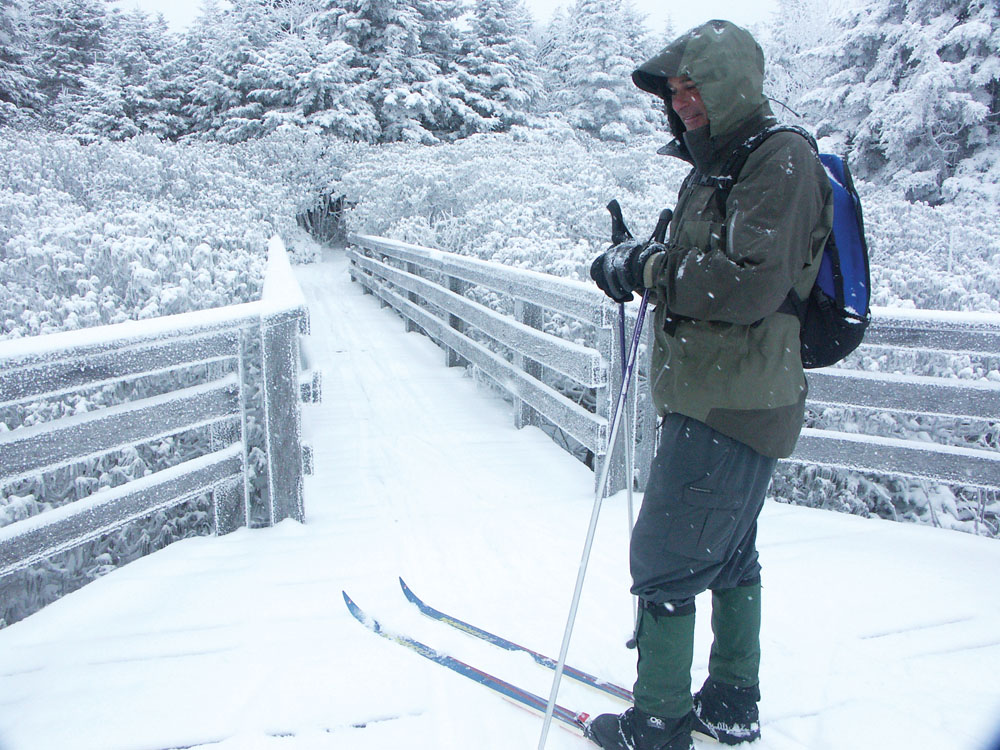 Nordic Nirvana
Nordic Nirvana
A tad more than thirty years ago, a crude advertisement appeared in The Mountain Times announcing a cross-country ski business that became an unusual footnote in the ski history of the United States. The ad read “Footslogger’s announces High South Nordic Guide Service.” The “largest staff of Professional Ski Instructor of America cross-country teachers in the South” were ready to take you on “day, overnight and custom ski tours” to the “snowiest summits in the South.” An evening program in early December 1980 promised a slide show, snacks, and excitement.
Three snowy, late 1970s winters sparked exploding interest in cross-country. High South Nordic Guides led trips from Footsloggers then hit upon an idea—Why not start a cross-country ski center just below snowy Roan Mountain? Tennessee’s Roan Mountain State Park was the perfect place, and after an unheard of—at least in the South—effort to convince a state to go into the cross-country ski business, Tennessee bought into the project. Then the state put the entire operation out for bid, to the shock of the fledgling entrepreneurs who’d devised the idea. After an eye-opening education in state politics—a local Tennessee legislator almost steered the business to a Tennessee outfitter—High South won the park’s “cross-country ski concession.”
“Boy, did that teach us a lesson,” says Steve Owen, one of the founders of High South Nordic Guides. The other principal was Jerome Barrett of Jonas Ridge, one of the North Carolina Outward Bound School’s key climbing instructors.
The state park took on a festive feel that first winter. With ample snowfall, the rental cabins and restaurant were bustling and the summertime campground became a cross-country ski shop. The atmosphere electrified the Nordic ski crowd. Newspaper reporters took lessons at the state park, then drove up to the winter wonderland of Roan Mountain for memorable first encounters with cross-country skiing. This was a new wrinkle to skiing in the South, and publicity was widespread. Tennessee governor Lamar Alexander and his wife Honey went skiing with High South on Roan Mountain and the photos appeared in dozens of newspapers. On one of those visits, the guides mentioned to Alexander that, “occasionally the road up to Roan Mountain, where the most snow falls, doesn’t get plowed very promptly.” The governor thought for a second and said, “Well, I think I might have some influence there.”
Hart Hodges, grandson of North Carolina Governor Luther Hodges, was one of High South’s ski instructors. James Randolph taught too, son of Alabaman Ted Randolph, who had been involved in the development of Sugar Mountain.
It wasn’t just “outlanders” on the Nordic scene. Pineola local Troy Clark won the first and last Mount Mitchell Cross-Country Ski Race by defeating 75 competitors over the 8-mile course.
During the heyday of the center, the Guides pioneered a rarity in the South—a relationship with the Forest Service that made them partners of sorts in managing the top of the mountain for recreational use. It was the Guides’ focus on skiing that encouraged the Forest Service to install the gate at Carver’s Gap. The focus on recreation helped diminish problems of illegal hunting and other activities on the mountain. The result—the snowy road to Roan became the Deep South’s premier place to cross-country ski.
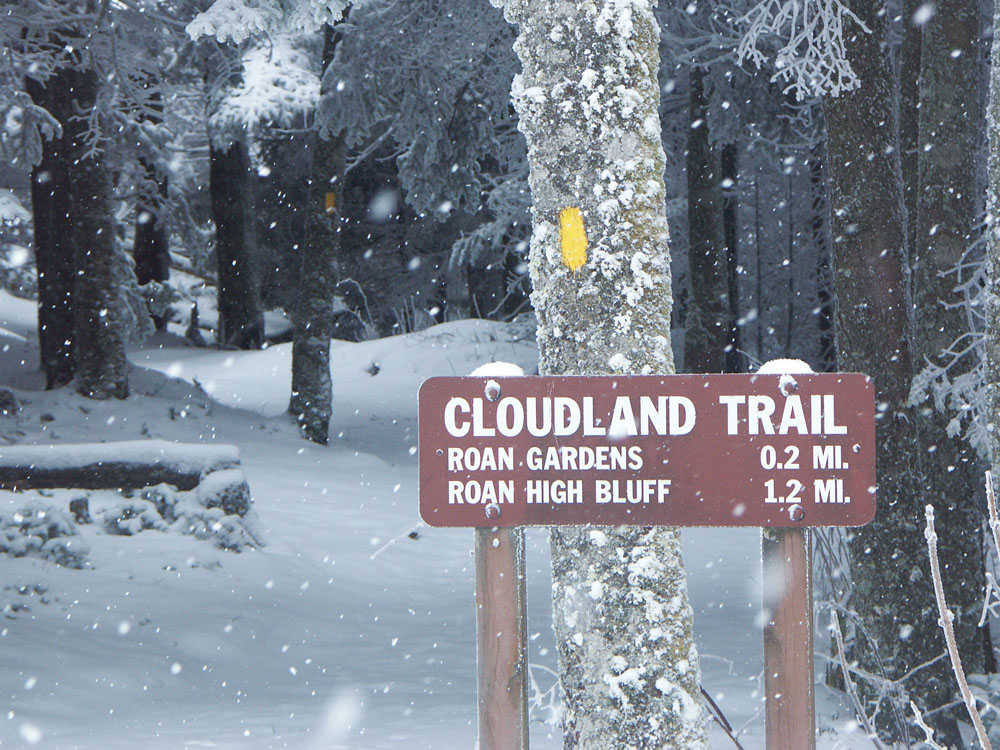 The Guides published a skiers’ map, maintained trails, and placed trail-rating signs (some still exist). They aided and informed skiers, and helped the unprepared escape severe weather.
The Guides published a skiers’ map, maintained trails, and placed trail-rating signs (some still exist). They aided and informed skiers, and helped the unprepared escape severe weather.
Then Alexander left office, and the Guides lost a key proponent of their vision for the park. The state frowned on snowmaking—and the Guides shut down their operation. A decade-long bubble of cross-country enthusiasm had burst.
As I looked around Carver’s Gap at the happy faces, I remembered once asking Owen if High South had been a waste of time. “Not at all,” he said. “Had we gotten the concession for the ski center and restaurant, gotten snowmaking, had summer programming, Roan Mountain state resort state park could have been an enduring business opportunity for people like us.”
“Our goals weren’t only economic,” he says. “We had a passion for our sport and how it and the winter woods affect people. When I think back, the image that comes to my mind is a snowy day at the state park, a full parking lot, and hundreds of people enjoying a sport that most would never believe was even possible in the South.”
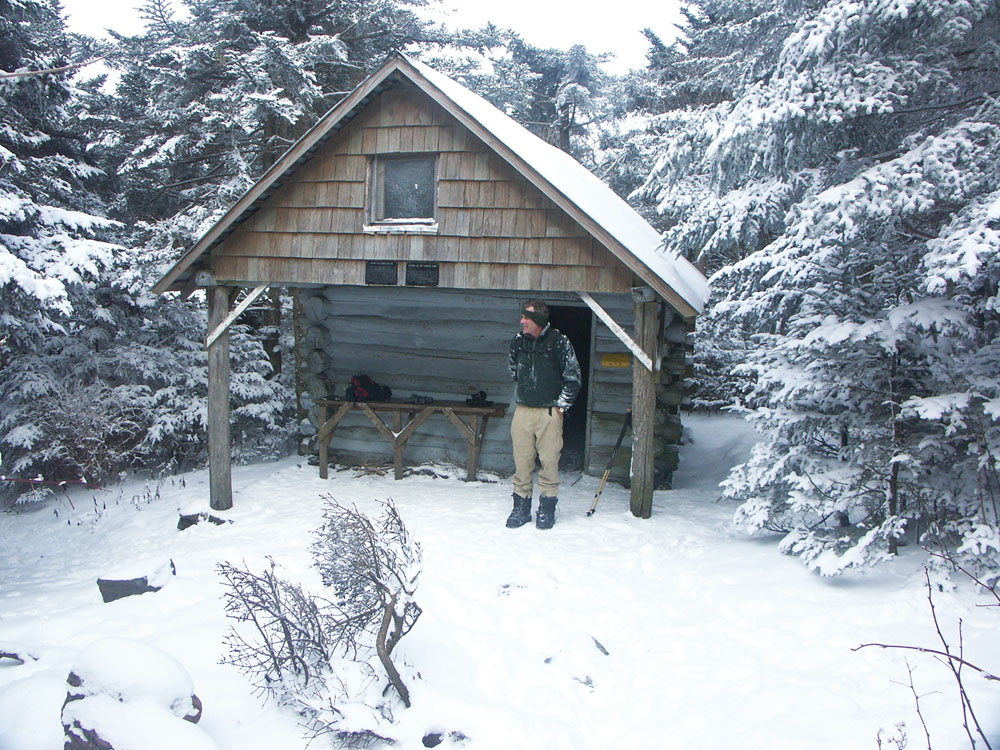
Epic Options
Thirty years later, Carver’s Gap still has the same energy, but with a new group of people in higher tech clothing.
If Carver’s Gap is the Roan region hot spot of winter backcountry, there are fewer people and exponentially more options elsewhere on the ridge. Using US 19-E, north of Spruce Pine and west of Newland, Roaring Creek Road runs high up under Yellow Mountain Gap, famous as the route of the Overmountain Men on their way to defeat loyalists in the Battle of King’s Mountain (they walked through the gap in September snow).
From the small parking area, it’s an easy ski to the left on a Forest Service access road to the A.T. and the huge Overmountain Shelter, a cavernous barn that’s a killer base for winter camping. Step past another gate at the lot and a side trail reaches Bright’s Trace, the actual colonial road that’s also a great route to the Gap. The A.T. soars up the meadows from there, to Little Hump and beyond on the ridge, and a web of fire roads brings you back down to your car.
The most direct route to Hump on the A.T. is another option out of Elk Park. The Apple House Shelter is not far from the road if a quick bivy is needed. Doll Flats, an outstanding campsite half-way to the summit, makes a nice base camp if you want to snowshoe the remaining few miles to the balds and ski from there. Last winter, the hundreds of acres of alpine-like balds across the crest of Hump saw their best skiing in years.
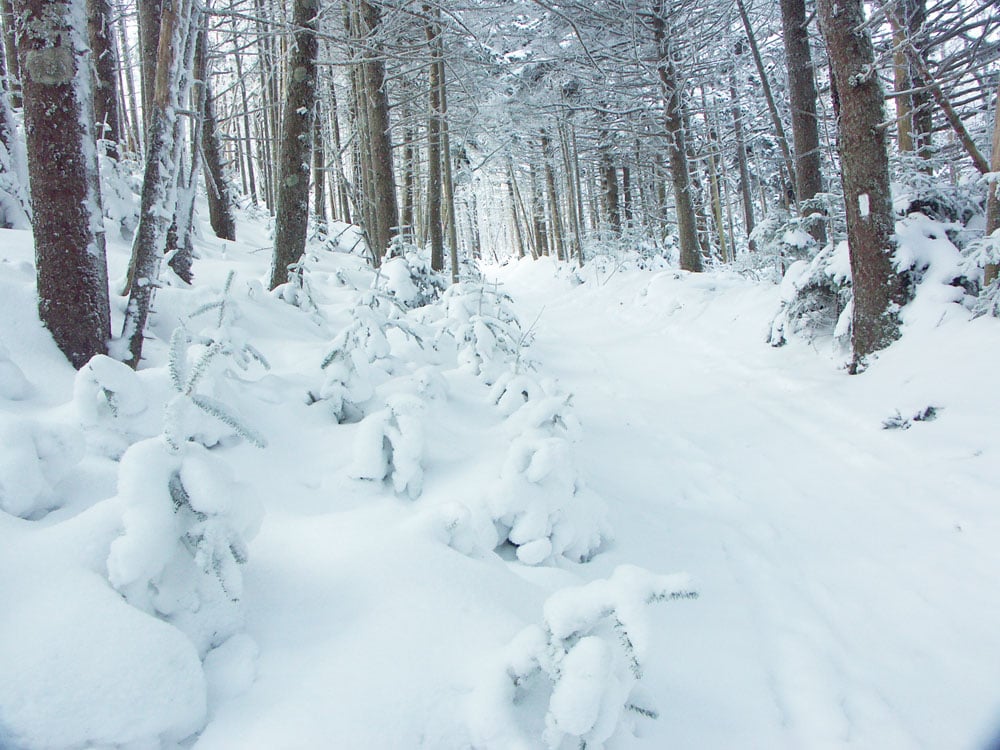 Last winter was truly an epic year for snow, and though hope springs eternal for another year like last, keep in mind, High South Nordic Guides discovered a key truth about the Roan area, lo those many years ago. When Ray’s Weather promises “significantly greater accumulations at higher elevations”—that’s the time to realize that every winter offers great skiing and mountaineering on these heights. You just have to go when the going’s good. And go where the going nets quick access.
Last winter was truly an epic year for snow, and though hope springs eternal for another year like last, keep in mind, High South Nordic Guides discovered a key truth about the Roan area, lo those many years ago. When Ray’s Weather promises “significantly greater accumulations at higher elevations”—that’s the time to realize that every winter offers great skiing and mountaineering on these heights. You just have to go when the going’s good. And go where the going nets quick access.
There are many ways to reach the balds, side roads here and there, routes past isolated homes where a curtain slides aside and a face casts a close look at cars that spin their way through the snow in the winter.
If you look beyond the forest, secret runs and routes still hide in the trees.
Randy Johnson and his buddies spend a winter weekend every year clearing the ski trails on Roan Mountain. He’s the author of Hiking North Carolina and Hiking the Blue Ridge Parkway. randyjohnsonbooks.com
